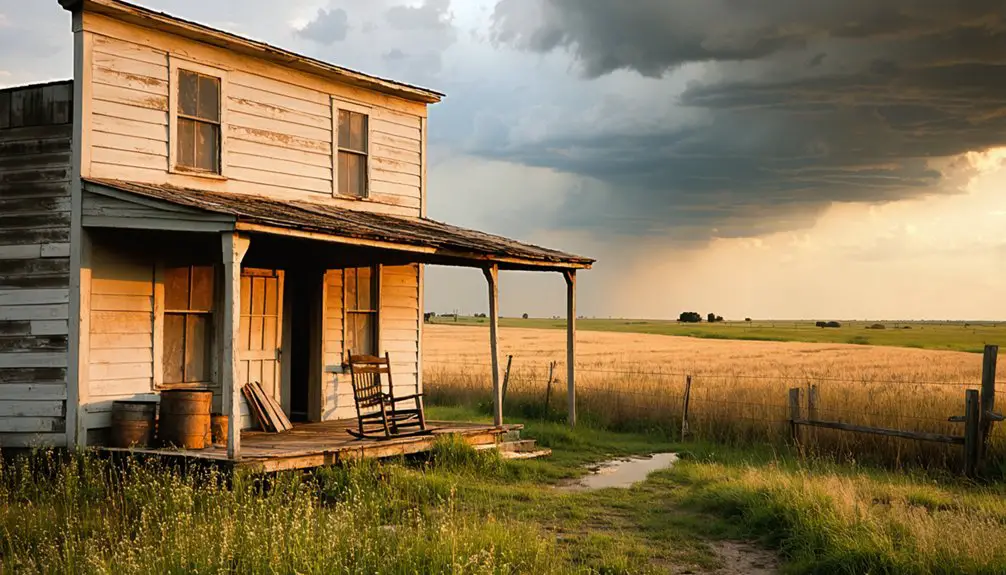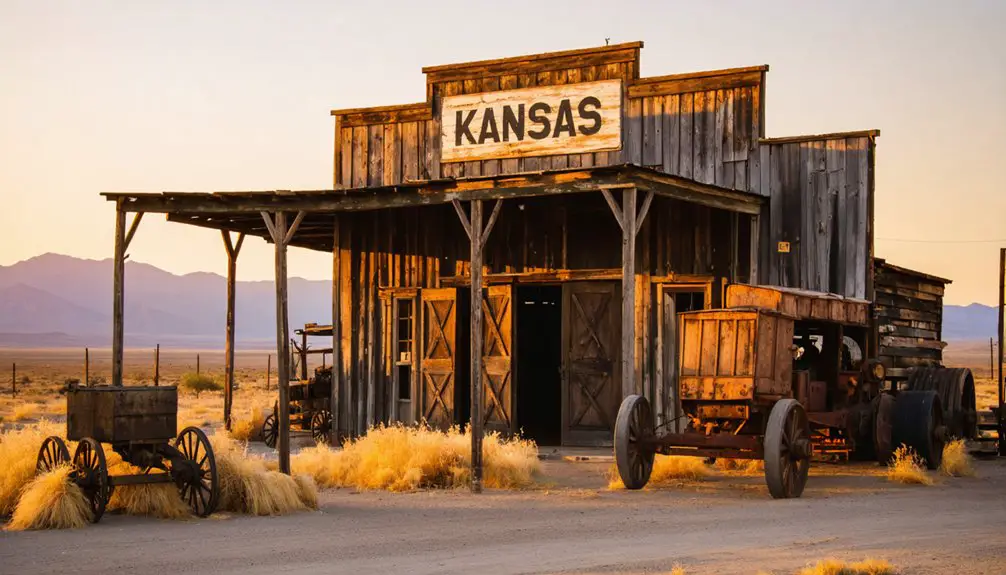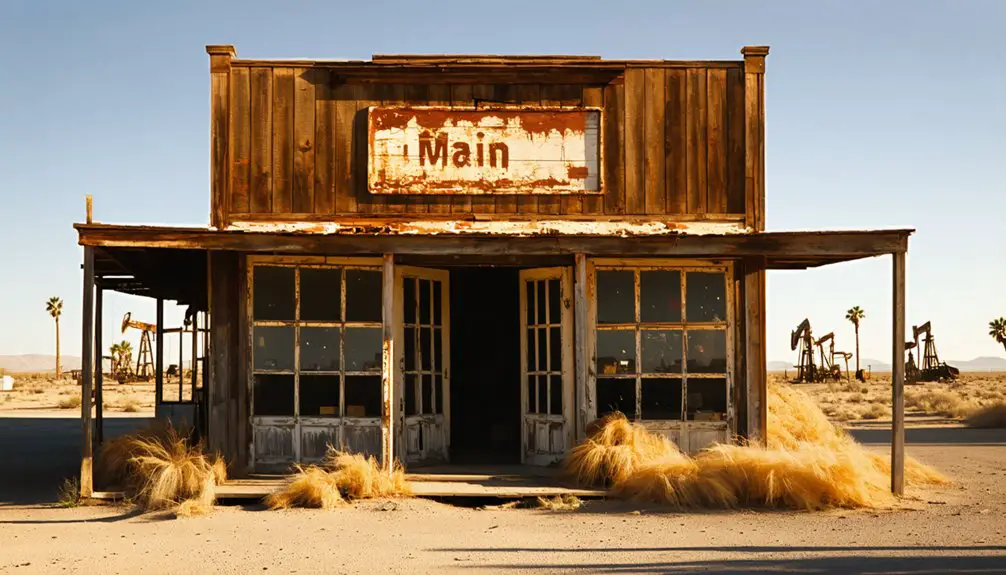You’ll find dramatic ghost town legacies in both California and Kansas, each shaped by different frontier dreams. California’s abandoned settlements emerged from the 1848 Gold Rush, with mining camps transforming into bustling towns before their swift decline. Kansas ghost towns tell stories of prairie pioneers, with over 5,000 settlements established around post offices and railroads in the mid-1800s. From Death Valley’s mining remnants to Kansas’s Nicodemus, these silent witnesses hold countless untold tales of America’s westward expansion.
Key Takeaways
- California’s ghost towns emerged primarily from abandoned gold mining operations, while Kansas ghost towns resulted from failed agricultural ventures and railroad bypasses.
- Both states experienced rapid town development in the mid-1800s, with California driven by gold discovery and Kansas by homesteading opportunities.
- Kansas lost over 5,000 towns due to economic changes, while California’s mining towns often lasted barely a decade before becoming abandoned.
- Environmental factors played crucial roles: California’s depleted gold reserves and Kansas’s Dust Bowl devastation led to town abandonment.
- Ghost towns in both states now serve as historical landmarks, preserving remnants of pioneer life, mining operations, and early settlement patterns.
The Rise of Mining Communities in the American West
When gold was discovered in California in 1848, it triggered one of the largest mass migrations in American history, fundamentally reshaping the western frontier.
You’d find thousands of prospectors rushing westward by sea and land, armed with simple panning equipment before mining technology evolved to handle deeper deposits.
As surface gold depleted, you’d witness mining camps transform into structured towns complete with hotels, saloons, and crucial services.
These communities drew diverse workers from across the globe – from English mining experts to Chinese laborers.
The rise of underground mining brought new challenges, leading workers to form labor unions advocating for better conditions.
Towns like Virginia City exploded to over 25,000 residents, while others became essential transportation hubs serving multiple mining operations.
Many towns experienced a boom and bust cycle, rapidly growing during mineral discoveries before declining when deposits were exhausted.
Initial mining operations were highly inefficient, with one-third to half of valuable minerals lost due to poor extraction methods.
Some settlements thrived beyond their mining roots, while others vanished once minerals ran dry.
From Boom to Bust: Economic Shifts and Abandonment
You’ll find that California’s once-thriving communities faced rapid decline as mining operations ceased, leaving behind empty buildings and abandoned rail stations that once connected these bustling towns to major trade routes.
The shuttering of mines rippled through local economies, altering active rail corridors into silent reminders of former prosperity while forcing residents to seek opportunities elsewhere. With median prices plummeting, Bakersfield’s newer neighborhoods show increasing signs of abandonment as foreclosures surge and residents migrate away.
Agricultural ventures that initially sustained these evolving communities gradually withered as economic pressures mounted, leaving vast tracts of formerly productive land to return to their natural state. The city of Fresno exemplifies this decline with 47% more homeless in just two years as small hospitals and factories close their doors.
Mining Towns Fade Away
The rapid decline of mining towns follows an almost predictable pattern of boom-and-bust cycles that defined America’s mineral extraction era.
You’ll find these settlements often lasted barely a decade before fading into obscurity, their fate sealed by resource scarcity and diminishing economic viability.
When mines shut down, you’d witness a swift exodus.
First, the transient miners would leave, followed by service businesses that couldn’t survive without their primary customers.
Schools would close, churches would empty, and once-bustling main streets would fall silent.
Even towns that supplied strategic materials, like Castle Dome’s lead for bullets, couldn’t escape this destiny.
The arrival of higher-quality coal by railroad hastened the demise of many local mining operations.
The 1907 financial panic hit these vulnerable communities particularly hard, accelerating their transformation from thriving settlements into abandoned shells of their former glory.
Death Valley alone contained over 100 ghost towns scattered across its harsh landscape, testament to the transient nature of mining settlements.
Rail Routes Turn Silent
As highways carved new paths across California’s landscape in the mid-20th century, rail routes that once served as lifelines for mountain communities fell silent.
You’ll find the remains of this rail transport history in places like Glenwood, Laurel, and Wright’s, where the South Pacific Coast Railroad once connected thriving settlements before its closure in 1940.
The ghost town economics became clear as highways offered cheaper, more flexible transportation alternatives to costly mountain rail routes.
Railroad companies sealed tunnels with dynamite, dismantled bridges, and pulled up tracks, erasing their physical presence.
The 6,208-foot Summit Tunnel beneath the Coast Range stood as the railroad’s greatest engineering achievement before its abandonment.
Chinese laborers played a crucial role in constructing these mountain railways, building numerous bridges and trestles across challenging terrain.
While some rail segments found new life in tourism, most faded into obscurity.
Today, you can trace these abandoned rail corridors where they parallel modern highways, marking the paths where mountain communities once flourished.
Agriculture’s Slow Death
While rail lines vanished from California’s landscape, a more profound transformation gripped agricultural communities throughout the early 20th century. You’d have witnessed the devastating decline of once-thriving farms that produced abundant harvests of apples, cowpeas, and potatoes.
Crop sustainability became impossible as the brutal 1930s Dust Bowl destroyed orchards and fertile soil alike. The region’s troubles mirrored those of nearby Bell Plane’s orchards, which had once been the area’s agricultural pride. Like many towns in Reno County, this settlement established a wind-powered mill to process grain from local farmers.
The march of mechanization fundamentally altered rural life, as tractors and combines replaced farm workers. You’d have seen younger generations abandon their family homesteads for urban opportunities, leaving rural revitalization efforts futile.
Local processing facilities and shipping centers closed their doors as specialized cash crops failed. The harsh realities of drought, soil erosion, and market competition converged to transform these vibrant farming communities into silent reminders of agricultural ambition.
Preserved History: Notable Ghost Towns of California
California’s ghost towns stand as compelling monuments to the state’s gold rush era, preserved through careful conservation efforts and historical designation.
You’ll find remarkable examples of ghost town preservation across the state, from Bodie’s “arrested decay” approach maintaining buildings exactly as they were left, to Cerro Gordo’s dramatic silver mining remnants perched high in the Inyo Mountains.
Each site carries unique historical significance – Shasta’s impressive brick buildings and courthouse tell tales of northern California’s mining prosperity, while Calico showcases restored structures and mining equipment near Barstow.
Whether you’re exploring Bodie’s merchant-filled interiors, examining Cerro Gordo’s extensive tunnel system, or walking through Ballarat’s quiet ruins, these preserved communities offer authentic glimpses into California’s rugged mining heritage.
Kansas Prairie Pioneers and Lost Settlements

While California’s ghost towns emerged from gold rushes, you’ll find Kansas’s abandoned settlements tell a different story of prairie pioneers who established over 5,000 towns centered around post offices, railroads, and agricultural communities.
You could have found these early settlements bustling with general stores, blacksmith shops, and two-story schoolhouses, as settlers endeavored to create permanent communities with dreams of becoming important county seats.
Sadly, many of these towns vanished due to railroad bypasses, environmental disasters like the Dust Bowl, or changing economic conditions, leaving only crumbling buildings and empty town squares as evidence of their pioneering aspirations.
Prairie Settlement Migration Patterns
During the mid-1800s, Kansas experienced diverse settlement patterns as pioneers arrived from multiple directions, each group bringing distinct cultural influences and political motivations.
The settlement dynamics reflected complex cultural assimilation as different groups sought their ideal communities. You’ll find that Missourians often claimed land with pro-slavery intentions, while Northern settlers faced challenging geographic barriers.
Russian-German and Mennonite immigrants carefully selected locations resembling their homeland’s agricultural conditions.
- Railroad proximity and water sources determined many settlers’ location choices
- Russian-Germans conducted thorough soil testing before establishing communities
- Mennonites sought compact settlements with self-governance options
- Irish immigrants contributed to early exploration and community building
- Political tensions between free-state and pro-slavery settlers shaped migration success
Homesteading Life and Hardships
Life on the Kansas prairie presented settlers with unrelenting physical and psychological challenges that tested their resilience daily.
You’d face the harsh reality of building sod homes that offered little protection from brutal weather, vermin, and persistent mud intrusions. Your farming success hung by a thread, as droughts, locusts, and poor soil conditions threatened crop survival.
The isolation of homesteading struggles often led to prairie madness – a psychological effect that manifested in depression, withdrawal, and sometimes violence.
Your family’s survival demanded grueling labor, with women and children working 11+ hours daily. You’d trap wildlife, share labor within families, and battle the elements while living in primitive conditions.
Many settlers ultimately abandoned their dreams, driven away by the overwhelming physical and mental toll of prairie life.
Lost Towns of Kansas
Throughout Kansas’s prairie landscape, abandoned settlements stand as silent witnesses to the ambitious dreams of pioneer life. From the historic Black pioneer town of Nicodemus to the “World’s Largest Living Ghost Town” of Elk Falls, you’ll discover ghost town legends that paint a vivid picture of Kansas’s pioneering spirit.
Rural preservation efforts have helped maintain these remnants of the past, ensuring their stories aren’t lost to time.
- Explore Decatur County’s wealth of lost settlements, including Bassetville and Hawkeye
- Visit Trading Post, one of Kansas’s first white settlements along the Marais des Cygnes River
- Discover the Free-State legacy of Quindaro, tied to the state’s abolitionist history
- Witness Oil Hill’s remaining structures, visible from nearby roads
- Experience Norway, a ghost town that still counts 17 residents as of 2020
Tourism and Heritage Site Development

As California’s ghost towns have evolved from abandoned settlements into heritage tourism destinations, local governments and preservation societies have implemented strategic development initiatives to capitalize on their historical value.
You’ll find heritage preservation efforts focused on protecting fragile historic structures while developing tourism infrastructure, though funding remains a constant challenge in remote locations.
You can explore these sites through new interactive maps and digital storytelling platforms that enhance your experience, while multi-site tour packages encourage longer stays.
Local historical societies are working to balance commercialization with conservation, creating educational programs and interpretive signage that tell authentic stories.
Despite tourism challenges like accessibility issues and market fluctuations, ghost towns continue serving as essential links to the region’s mining and railroad heritage, offering unique opportunities for both entertainment and historical understanding.
Legacy and Impact on American Culture
While California’s ghost towns stand as physical reminders of the past, their influence extends far beyond crumbling buildings and abandoned mines into the fabric of American cultural identity.
Like fading photographs etched in stone, California’s ghost towns whisper stories that shaped America’s very soul and spirit.
You’ll find these sites shape your understanding of economic cycles through boom-and-bust narratives that define the American West. They’ve become powerful symbols of cultural nostalgia, reflecting both the dreams and harsh realities of frontier life.
- Discover authentic remnants of pioneer spirit in preserved mining camps and cow towns
- Experience the physical manifestations of American entrepreneurship and resilience
- Explore the complex histories of diverse populations, including Indigenous peoples and immigrant laborers
- Witness the impact of industrialization and resource extraction on Western settlement
- Understand how these sites continue to influence modern interpretations of frontier mythology
Frequently Asked Questions
Are There Any Documented Paranormal Activities in These Ghost Towns?
You’ll discover countless ghost sightings at Bodie’s haunted locations, where spirits cook phantom meals and a cursed girl giggles in the cemetery, while Kansas towns offer less documented but intriguing paranormal encounters.
Can Visitors Legally Collect Artifacts From Abandoned Ghost Town Sites?
You can’t legally collect artifacts from ghost towns without proper permits and landowner permissions. Legal regulations protect these sites for artifact preservation, with serious penalties for unauthorized removal.
What Survival Equipment Should You Bring When Exploring Remote Ghost Towns?
You’ll need water filtration, first-aid supplies, navigation tools, emergency shelter, and sturdy boots. Don’t forget a multi-tool, flashlight, and signaling devices for essential gear and safety tips.
Do Any Ghost Towns Still Have Year-Round Residents Today?
Like scattered seeds in an abandoned field, you’ll find some ghost town communities do maintain year-round residents today, particularly in Kansas where private landowners and farmers continue living on historically depopulated properties.
How Dangerous Are Abandoned Mine Shafts in Ghost Town Areas?
You’re risking your life near abandoned mine shafts – they’re extremely dangerous with sudden collapses, deadly gases, fatal falls, and unstable ground. Don’t explore without proper safety precautions and professional guidance.
References
- https://en.wikipedia.org/wiki/List_of_ghost_towns_in_California
- https://californiahighsierra.com/trips/explore-ghost-towns-of-the-high-sierra/
- https://dvnha.org/info-trip-planning/ghost-towns/
- https://dornsife.usc.edu/magazine/echoes-in-the-dust/
- https://www.geotab.com/ghost-towns/
- https://www.loc.gov/collections/meeting-of-frontiers/articles-and-essays/development/mining-in-the-west/
- https://hobblecreek.us/blog/entry/mining-towns-of-the-old-west
- https://westernmininghistory.com/map/
- https://www.nps.gov/deva/learn/historyculture/perils-of-opportunity-the-mining-towns.htm
- https://www.identecsolutions.com/news/mining-in-us-70-centuries-of-history



